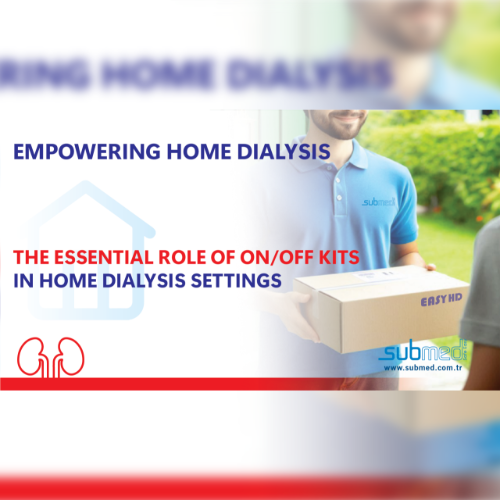
Establishing a home dialysis setup is essential for patients managing their renal care, as it empowers them to take control of their treatment in a familiar environment. However, maintaining a sterile environment is critical to preventing complications and ensuring patient safety. Statistics indicate that approximately 15-30% of patients undergoing dialysis experience infections related to their access sites, with dressing-related infections being a significant contributor. Inadequate sterility can heighten the risk of infections, particularly in home dialysis, where access sites are used frequently. By prioritizing sterile practices and utilizing the appropriate materials, patients can substantially reduce their risk of infections. Thus, both the setup of a home dialysis system and the commitment to maintaining a clean, sterile environment are vital for effective home dialysis care, ultimately leading to better health outcomes and improved quality of life.
Dialysis fistula and catheter on/off kits are crucial components of home dialysis, significantly impacting patient safety and treatment efficacy. These kits empower patients to manage their vascular access securely within their homes, much like the supplies used in clinical settings. Each kit is thoughtfully designed to provide essential tools for daily access site management, acting as a vital resource for individuals undergoing home dialysis.
Typically, these kits include adhesive dressings, gloves, plasters, antiseptic wipes, and other necessary items, playing a pivotal role in preventing infections and ensuring proper maintenance of access sites. Their user-friendly design makes them convenient for patients to carry and use, whether at home or on the go. By facilitating daily care routines, on/off kits enhance the home dialysis experience, making them indispensable for patients managing their treatments independently.
Despite their importance, the significance of using sterile materials and dressings in home dialysis is often underestimated, which is a serious oversight. Many patients may not fully grasp the critical role these kits play in their safety and treatment efficacy. In a home environment, factors such as dust, pets, and everyday activities can compromise sterility. Therefore, relying on sterile supplies is essential to minimize the risk of infections and ensure patient safety. Maintaining proper hygiene and using sterile materials is crucial for effective home dialysis care.
SUBMED with EASY HD product family offers all the necessary components for effective home dialysis, ensuring patients have access to high-quality supplies tailored to their specific needs.
Home dialysis service providers and renal group purchasing organizations (Renal GPOs) must prioritize the availability and quality of on/off kits. Ensuring that patients have access to well-designed, comprehensive kits is essential for supporting their safe and effective management of treatments. By focusing on the distribution of these kits and integrating education on their proper use into training programs, providers can significantly enhance patient outcomes. This proactive strategy not only bolsters patient safety but also fosters confidence and independence among individuals managing their dialysis at home.
Please also see:

The Critical Role of Dialysis Fistula and Catheter On/Off Kits in Comprehensive Renal Care and Renal GPOs
Peritoneal Dialysis (PD): Studies published in journals such as Kidney International and the Clinical Journal of the American Society of Nephrology have identified that patients on PD are susceptible to peritonitis, a serious infection of the peritoneum. The rates of peritonitis can vary but remain a significant concern in home dialysis care. This condition can lead to severe complications, including hospitalization and the necessity for catheter removal, which disrupts ongoing treatment.
Home Hemodialysis (HHD): Research indicates that patients on home hemodialysis are also at risk for infections, particularly at the vascular access site. Articles in the American Journal of Kidney Diseases demonstrate that infection rates can differ based on the type of access used (fistula vs. catheter) and the management practices in place. For instance, patients with central venous catheters generally face higher infection risks compared to those with arteriovenous fistulas.
General Findings: A systematic review published in BMC Nephrology highlighted that home dialysis patients experience varying rates of infection compared to those receiving in-center dialysis. Certain practices in home care can potentially increase the risk of healthcare-associated infections (HAIs) if not managed properly. The review emphasizes that the lack of direct oversight in home settings may lead to lapses in aseptic techniques, further elevating infection risks.
Longitudinal Studies: Long-term studies have revealed significant infection rates among home dialysis patients. Reports indicate that patients on PD may experience peritonitis rates of approximately one episode per 18 patient-months. Similarly, home hemodialysis patients can exhibit infection rates that require close monitoring and proactive management strategies.
Infection Prevention: The kits provide sterile materials that help maintain a clean access site, significantly reducing the risk of healthcare-associated infections.
Convenience: Each kit is designed for easy portability, allowing patients to manage their dialysis care effortlessly at home or while traveling.
Comprehensive Care: The inclusion of essential items in one kit simplifies the management of vascular access, ensuring that patients have everything they need for effective care.
Improved Patient Confidence: With the right tools and education, patients feel empowered and capable of managing their own care, leading to greater satisfaction with their treatment.
Consistency in Care: Standardized kits help ensure that patients follow the same procedures each time, promoting consistency in the management of their dialysis treatments.
In summary, the integration of dialysis fistula and catheter on/off kits into home dialysis setups is essential for ensuring patient safety, enhancing the effectiveness of treatment, and improving overall health outcomes.